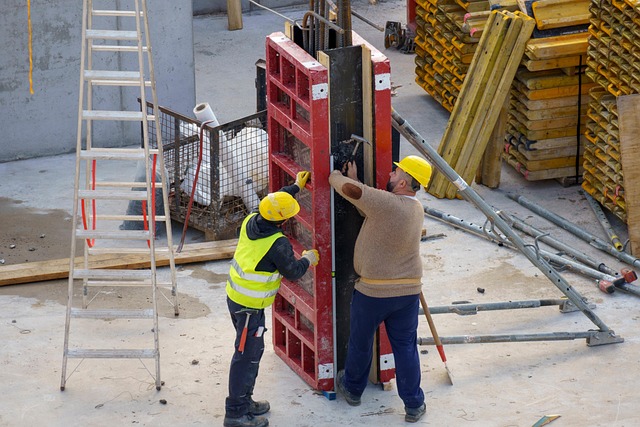3D BIM modeling, powered by Augmented Reality (AR) and Virtual Reality (VR), is transforming construction and design. These technologies create detailed virtual replicas of buildings, including material properties, cost estimates, and maintenance requirements. By offering a unified platform for architects, engineers, contractors, and owners, 3D BIM models improve communication, streamline workflows, reduce errors, and enhance project efficiency. AR integrates digital models with physical spaces, facilitating better spatial understanding and informed decision-making. VR immerses users in 3D BIM environments, allowing stakeholders to collaborate, communicate, and inspect designs virtually before construction begins, revolutionizing the way digital construction models are interacted with.
In the ever-evolving landscape of construction and design, the integration of Augmented Reality (AR) and Virtual Reality (VR) with Building Information Modeling (BIM) is revolutionizing industry standards. This article delves into the transformative power of these technologies, enhancing 3D BIM modeling through immersive visualizations and interactive experiences. From understanding the fundamentals of BIM to exploring advanced applications, we unravel how AR and VR are reshaping the way we conceptualize and interact with digital construction models.
Understanding BIM: The Foundation of 3D Modeling
Building Information Modeling (BIM) serves as the cornerstone for modern construction and design processes, revolutionizing how professionals visualize and interact with digital representations of structures. At its core, 3D BIM modeling involves creating precise, detailed virtual replicas of buildings or infrastructure, incorporating not just geometric shapes but also a wealth of information attached to each element. This includes material properties, cost estimates, scheduling data, and even future maintenance requirements.
By embracing 3D BIM modeling, industry professionals gain a powerful tool for collaboration and decision-making. It enables stakeholders from architects, engineers, contractors, and owners to work on a unified platform, enhancing communication and streamlining project workflows. This integrated approach fosters better coordination, reduces errors, and ultimately contributes to more efficient and successful project outcomes.
Augmented Reality: Enhancing BIM Visualization
Augmented Reality (AR) offers a compelling way to enhance the visualization and interaction with 3D BIM models, bringing digital building designs into the real world. By overlaying virtual information onto physical spaces, AR technology allows users to explore complex architectural concepts in a more intuitive manner. For instance, construction professionals can virtually place and manipulate 3D BIM objects in their actual work environment, facilitating better spatial understanding and decision-making.
This integration provides an immersive experience by linking digital models with the real world, making it easier to identify potential issues early in the design phase. AR can also aid in training and education, enabling students and practitioners to interact with 3D BIM structures as if they were physically present, enhancing learning outcomes and fostering innovation in building design.
Virtual Reality and Its Role in BIM Immersion
Virtual Reality (VR) plays a pivotal role in enhancing the immersion and interactivity of Building Information Modeling (BIM). By donning a VR headset, professionals can step into their digital creations, experiencing 3D BIM models as if they were real. This immersive environment allows for a deeper understanding of spatial relationships, visual inspection of intricate designs, and practical simulation of construction scenarios. With VR, architects, engineers, and contractors can virtually walk through buildings, identify potential issues, and make informed decisions before the physical construction phase begins.
The integration of VR with BIM offers a more engaging and intuitive approach to 3D modeling. It provides an opportunity for stakeholders to collaborate and communicate effectively using shared virtual spaces. This technology enables real-time visualization and manipulation of complex building structures, promoting better coordination and accuracy throughout the project lifecycle. As VR continues to evolve, its potential in revolutionizing the way we interact with digital construction models becomes increasingly apparent.
Integrating AR and VR for Advanced BIM Applications
The integration of Augmented Reality (AR) and Virtual Reality (VR) with Building Information Modeling (BIM) opens up new frontiers in 3D BIM modeling and construction visualization. AR enhances real-world environments by overlaying digital information, while VR creates immersive, virtual spaces. Combining these technologies within the BIM framework allows for a more interactive and dynamic representation of architectural designs.
For advanced BIM applications, AR enables users to visualize and interact with 3D models in real space, providing a practical, on-site perspective. This is particularly beneficial during construction, facilitating better spatial understanding and enabling potential issues to be identified early. VR, on the other hand, offers a fully immersive digital twin of a construction site or building, allowing stakeholders to experience and navigate through the design virtually, fostering collaboration and informed decision-making.
The integration of Augmented Reality (AR) and Virtual Reality (VR) with Building Information Modeling (BIM) represents a significant leap forward in the construction industry. By combining these technologies, professionals can achieve unprecedented levels of visualization, immersion, and collaboration. AR enhances BIM’s 3D modeling capabilities by overlaying digital information on real-world spaces, while VR provides fully immersive environments for detailed design reviews and project walkthroughs. This fusion of AR and VR with BIM offers advanced applications that streamline workflows, improve decision-making, and ultimately lead to more efficient and successful construction projects.
